Tropicfeel Hive Backpack Review
Tropicfeel’s Hive Backpack is elegantly modular and is compatible with their packing cube, wardrobe, and camera cube, but lackluster without the add-ons.
Our Verdict
Save time. Get access to brief summaries of our reviews so you can browse and make decisions more efficiently.
Pros
- Durable, easy-to-use materials and hardware
- Compatible modularity with other Tropicfeel products
- Well-designed, comfortable harness system
Cons
- Laptop storage in the lid doesn’t feel safe
- Backpack doesn’t feel as useful without add-ons
- Larger users may find the harness system ill-fitting
Technical Details
-
Capacity
22l
expandable to 26L and up to 46.5L with accessories
-
Weight (lb)
3 lb (1.4 kg)
-
Dimensions
19.3 in x 12 in x 6.7 in (49 x 30.5 x 17 cm)
(normal) | 19.3 in x 12 in x 7.9 in (expanded)
-
Notable Materials
Recycled Polyester, YKK Zippers, Duraflex Hardware, Aluminum
-
Manufacturing Country
Vietnam
-
Laptop Compartment Size
16"
-
Warranty Information
Full Review
The Tropicfeel Hive has been marketed as the perfect backpack for those entering the digital nomad world, and for good reason. With all the accessories, you won’t have to purchase much else before your first trip. However, we can’t help but wonder whether all the shiny accessories (and their steep price tag) are worth all that hoopla. Let’s dive in and find out!
External Components
The primary pack material on this travel backpack is recycled polyester, which is more sustainable than non-recycled materials. It feels premium, looks sleek, and has solid durability and water resistance. As far as fabric goes for a pack like this, we are happy with it.
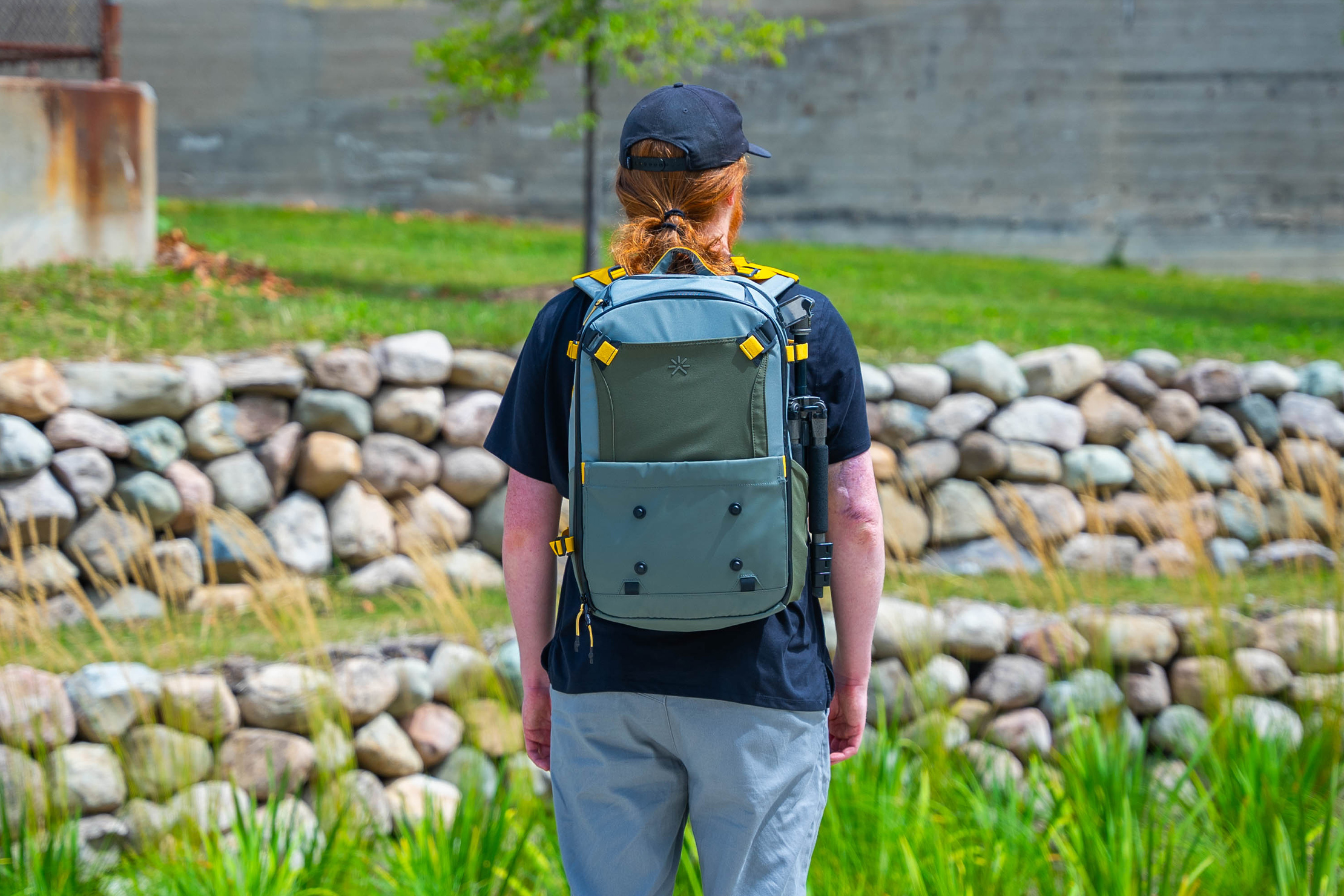
There are three colorways to choose from at the time of writing, Core Black, Mulled Green, and Walnut Sand. They’re all sleek; however, the black model is much more stark than the others. All three options blend nicely in an urban or rural environment, so you won’t stick out like a sore thumb while traveling globally.
The zippers on the Hive are from YKK. This is one of the top zipper brands, at least at the time of writing, and they work as we’d expect them to.
The buckle hardware is a mixture of Duraflex and aluminum fasteners. The hard plastic models from Duraflex are snappy and easy to use. The metal hooks are durable, sleek, and easy to get on and off. On a rare occasion, the metal fastener might pop off, but only when put in unusual circumstances—but we’ll get to that later.
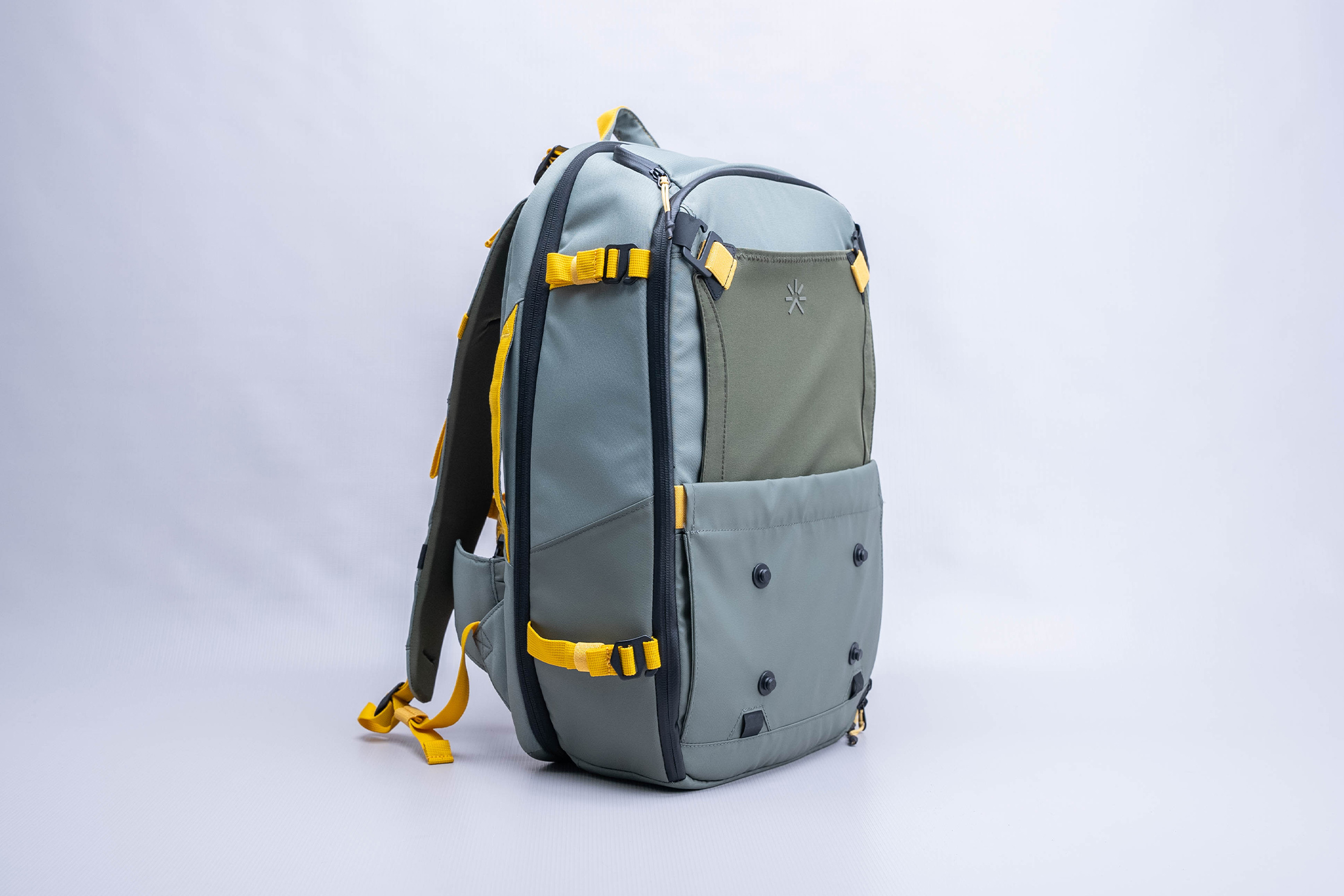
The bottom of the pack’s front has four attachment points resembling nipples. You can use them to attach the dopp kit or tech pouch to the pack’s exterior with their included FIDLOCK fasteners. This ensures you have quick access to one of them at all times, depending on what your use case is. The tech pouch makes sense if you’re heading to the coffee shop. The toiletry kit is a good idea for the airport after a redeye.
Below those are two attachment loops that work independently to attach gear or for the Kangaroo pocket on the bottom, which we’ll get into later.
Above the nipples, there’s a large pocket with a stretchy material and two metal attachment hooks. When not in use, this hides away in the area just mentioned. However, you can unfold it and lash on the 12-liter Smart Packing Cube. It slides into the pocket, and you can feed the metal hooks through the loops on the cube’s corner to secure it. This ensures you can still fit a ton of gear inside the pack.
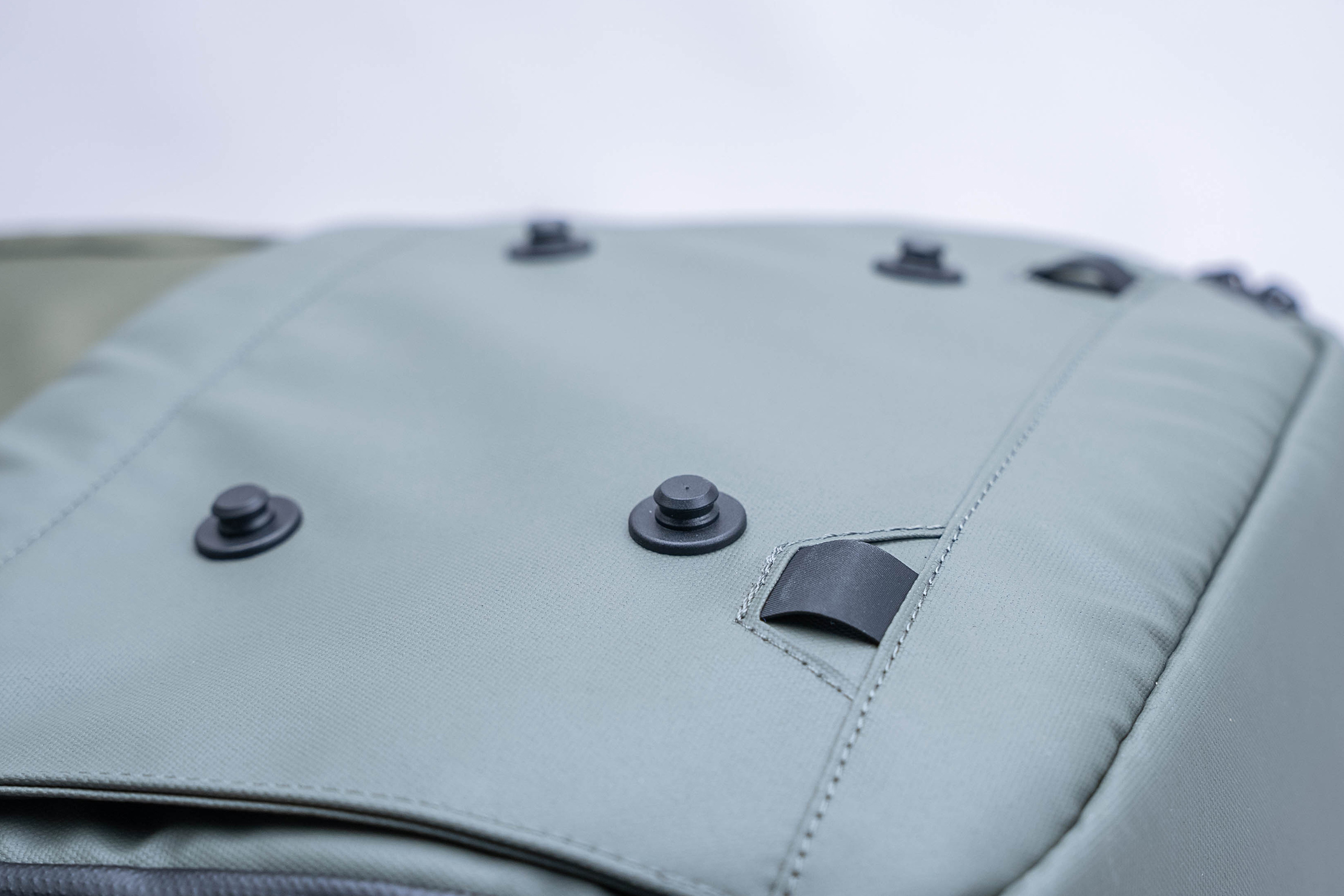
One of the sides has a water bottle pocket. It’s stretchy but won’t fit a larger bottle like a 32-ounce Nalgene. Thanks to the stretchy compression strap above, you can use it to stow a bigger item like a tripod. Throw one or two legs of your tripod in the water bottle pocket, put the elastic band of the compression strap around the top, and you’re ready to go. This might not work for thick tripods because the elastic can only stretch so far. However, you can feed the band through the legs to secure it in a pinch. It’s a good size for a smaller travel umbrella, too.
On one occasion, while doing some urban exploring, the tripod in the side pocket brushed up against a brick wall, and the metal hook popped out of its socket. It was a small tripod, so it didn’t fall, but it was surprising. However, this only happened one time.

There’s no water bottle pocket on the other side of the pack, but there are two compression straps. These aren’t elastic—but they’re longer and can be adjusted. You can use these to attach an assortment of items, from ice picks to hiking poles. Certain tripods will also be able to fit here, since the straps are far enough apart to handle long things, which we dig.
A trolley sleeve (or luggage pass-through) on the back panel makes attaching the pack to your rolling luggage easy. However, many of the features of this pack are superfluous if you have a larger bag. Why are you looking to save space with the packing cubes and other accessories if you’ve got a ton more room to work with? Luckily, using the pack with additional baggage isn’t the only reason for this feature. You can also use it to lock down the shoulder straps to carry the bag instead. One end of the strap has a metal hook you can undo and reattach after securing the shoulder straps. They aren’t stowed away, but they’re not going anywhere while you use one of the handles.
There are two handles to carry the bag: one on the top and one on the side. The higher iteration has more material to work with, which makes sense. You don’t want a handle getting in the way while trying to lay your pack on its side. Neither has much padding, but they’re comfortable to hang onto for a short period. After all, you’ve got shoulder straps to use when the going gets tough.
Fit Notes

The shoulder straps on the Hive have a fair amount of padding and are covered in mesh, which helps with breathability. They’re shaped like an S to conform to your body, but this won’t work for all body types. However, we’ve found it to be a fairly comfortable pack. It feels more like a daypack than a travel backpack, depending on how you’ve got it packed out.
There are multiple attachment loops on the shoulder straps: vertical and horizontal straps, dangling loops, and elastic material are running down so you can attach various items while in transit.
At the top are load lifters, which help shift the weight and make the pack more comfortable. They’re easy to adjust and stay put while in use, but we’ve noticed them slipping slightly when not fully engaged. Overall, they’re a solid addition.
There’s a sternum strap that’s on a rail, which makes it easy to find the perfect fit. It doesn’t slide too easily, so you won’t lose your spot, but you can manipulate it quickly enough when you need to.
The back panel is well cushioned, but it’s pretty sturdy. Some users will enjoy this stability, whereas others might wish for more padding. There’s mesh here, too, which assists in breathability alongside the air channels built into the Hive’s back panel. It’ll still get sweaty on a hot summer’s day; however, it breathes better than many packs we’ve tested.
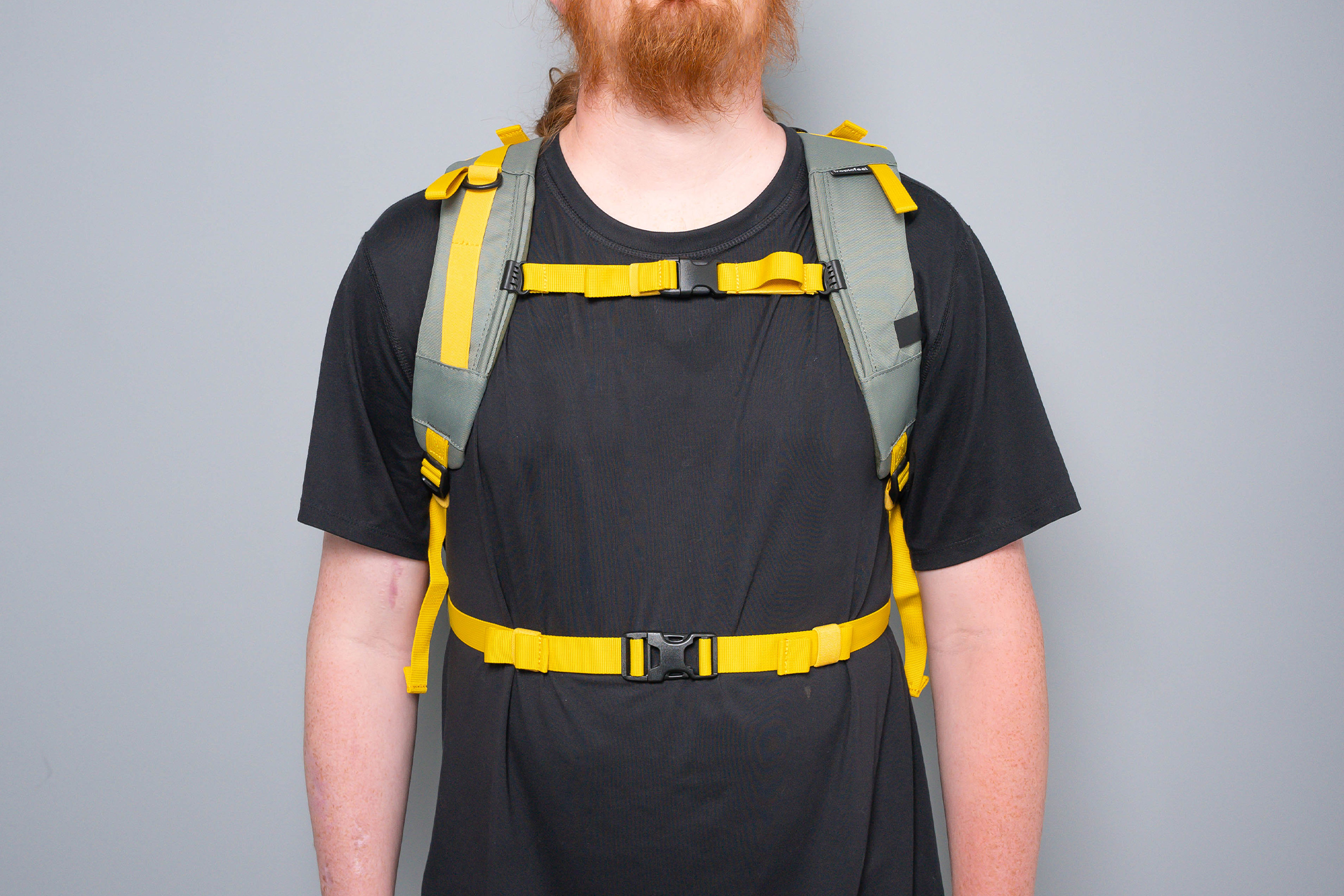
The hip belt is where things start to get interesting. The straps are comfortable; however, they ride pretty high, making it more of a belly belt. You can take it off and use it as a sling. The bulk of the materials are hidden behind the Hive’s back panel, which we think is pretty ingenious. It’s called the Adaptable Bum Bag, and it’s pretty tiny. However, when used as a hip belt, it works as well as those on other packs that aren’t removable. It secures inside the pack with two small hook and loop fasteners, so it won’t slide out accidentally. Plus, you can use it once you get to your destination, and it matches your pack. How neat is that? (We’ll answer that for you, it’s really neat!)
Inside The Pack
We’ve got quite a few compartments to go over, so let’s dive in.
A pocket on the top of the pack is the quickest to get into while using the bag. It’s a good size for daily essentials like your phone, wallet, keys, and sunglasses. There’s a smaller compartment inside to lock down sensitive or smaller items like headphones or medication. The liner here is soft so that you can put electronic devices here without worry.
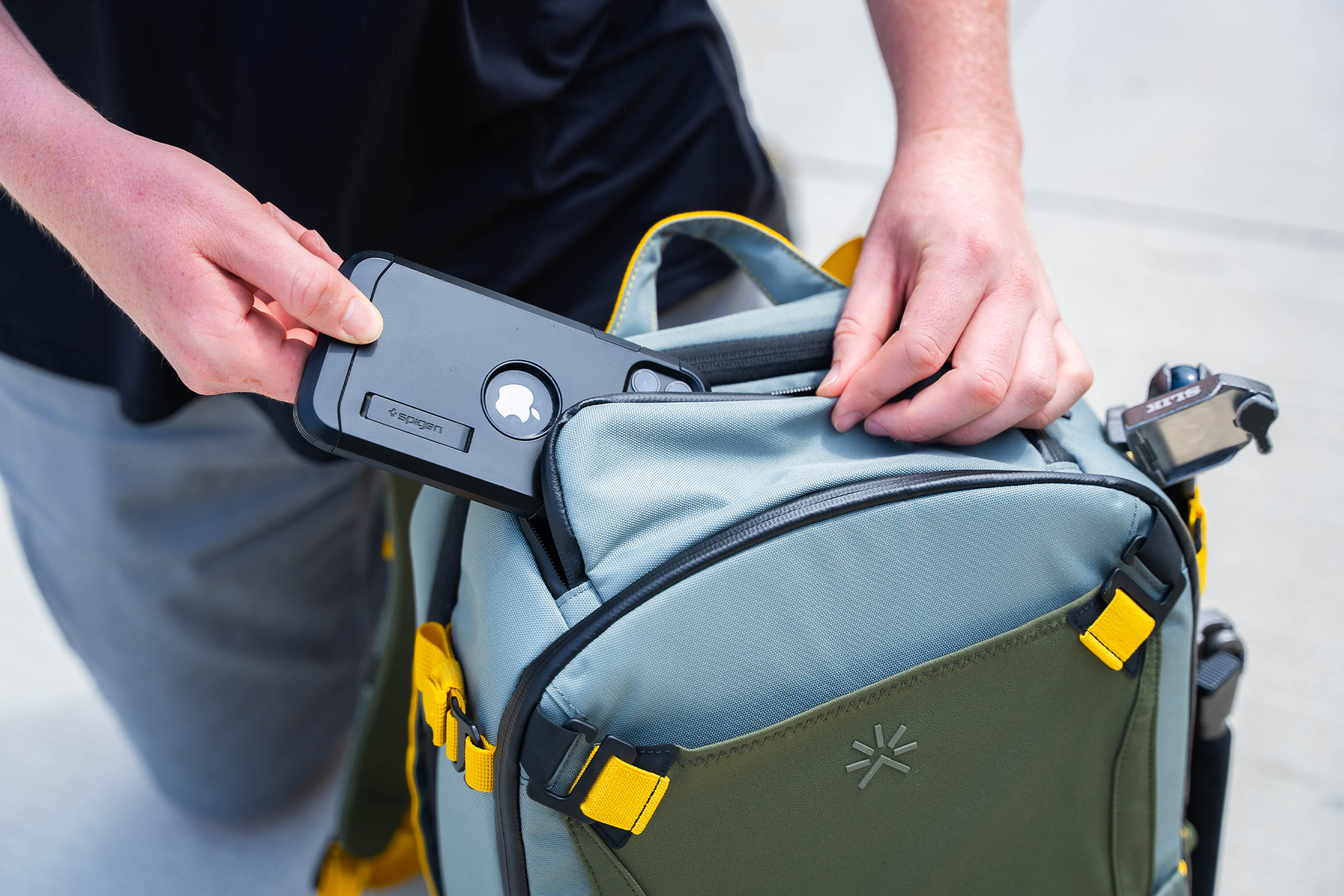
Moving over to the back panel, there’s a hidden pocket on the side of the padding. It’s concealed when wearing the pack and would be hard to access even if someone knew where it was because it’s on your back. This is a solid spot for items like a passport, a wallet, or other personal information. If you’ve got a thicker wallet, you might be able to feel a bulge when you put the pack on.
There are two zippers on the pack’s bottom—let’s chat about the smaller one closer to the front. Earlier, we mentioned the Kangaroo Pocket—this is it! A large chunk of material comes out of the zipper, like when you unpack a packable rain jacket, and it has two metal hooks that you can attach to the black attachment loops on the bottom of the pack’s front face. This is an excellent spot to stow dirtier items, like shoes or flip-flops, or you can use it for a travel water bottle that’s too large for the pocket on the side. Whatever you stow here becomes the bottom of the pack, so we wouldn’t place anything breakable inside. Or, if you put something that isn’t very flat or long, it may stop the bag from sitting up on its own or cause it to tumble over, so be careful where you set it. Of all the modularity offered by the Hive, this one might have the broadest range of uses. You can put anything in there!

Now it’s time to head into the main compartment. At first glance, there isn’t much going on here. However, it all starts coming together after further inspection (or watching a Tropicfeel instructional video).
There are two mesh pockets on the back panel with zippered closures. These are ideal for items you want to keep track of but don’t need on the pack’s exterior.
The lid has two more mesh zippered pockets, one relatively large and another smaller iteration. Above that, a hook and loop fastener secures the laptop compartment. We’re torn on the computer’s placement for two reasons. One, it’s a great use of space and ensures you can pack more into the main compartment. However, there isn’t a ton of padding on the lid, so if you open the lid quickly, your laptop will bang against whatever surface you’ve got the pack set upon. It’s pretty easy to remember that it’s there because of the weight, but having a dead laptop as a digital nomad wouldn’t be ideal.
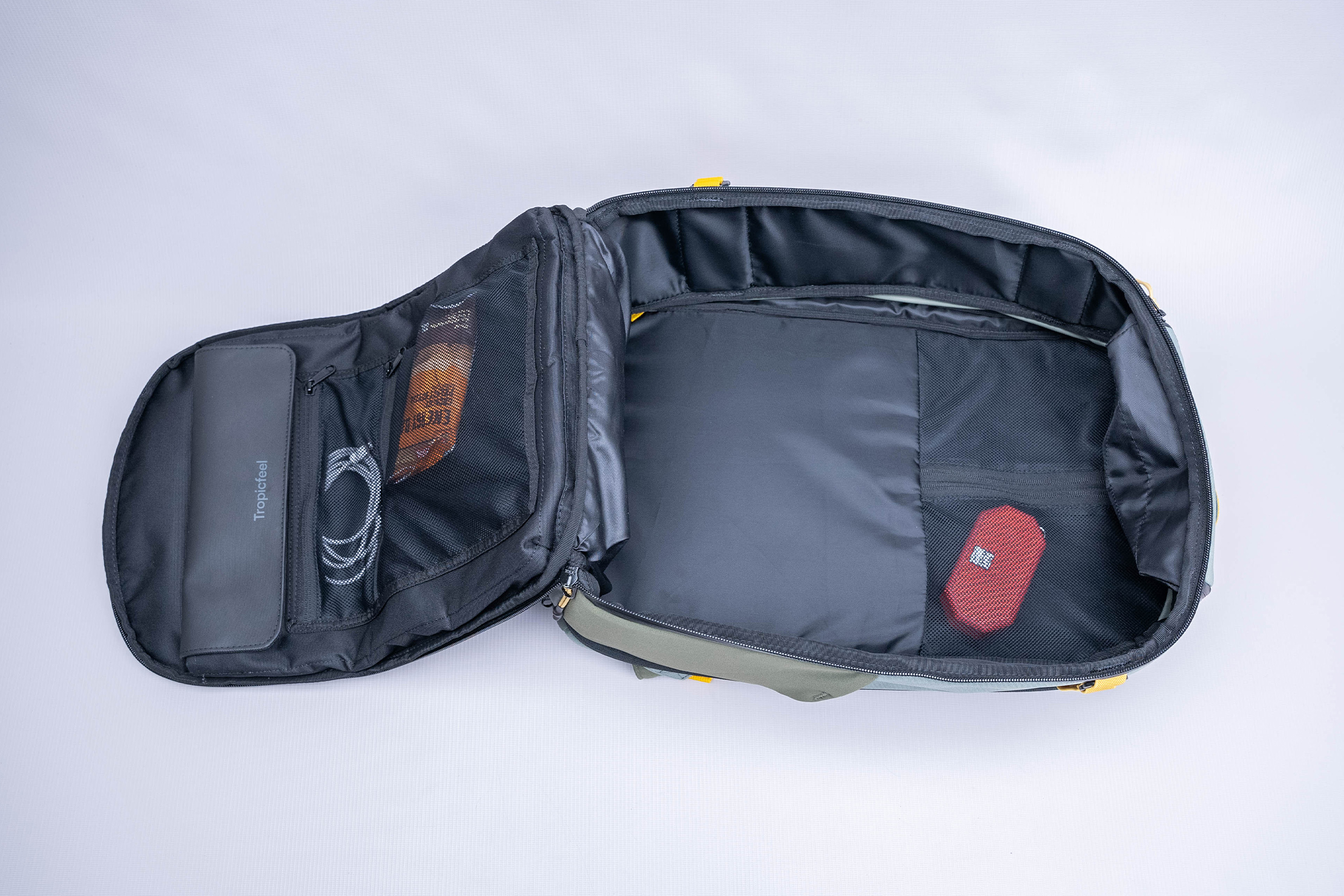
Additionally, some users don’t like having weight that far from their back, citing that it isn’t as comfortable, but that will depend on your preference and how you use this pack.
Apart from that, there’s nothing else in the main compartment. However, that doesn’t mean it isn’t helpful in other ways.
You can stow two modular pieces inside the main compartment—the Tropicfeel Wardrobe and the Camera Cube XXL—but not at the same time.
The Tropicfeel Wardrobe is just as the name describes; a wardrobe made by Tropicfeel for their travel backpacks. Essentially, you load all your gear inside the intensely organized and compartmentalized packing cube sections, cinch down the side straps, and fit it inside the pack. It’s a great way to use the bag once you arrive, too, because once you remove it, you can hang the Wardrobe up in your hotel room or Airbnb and take the Hive with you as a daypack (and sling, don’t forget!).
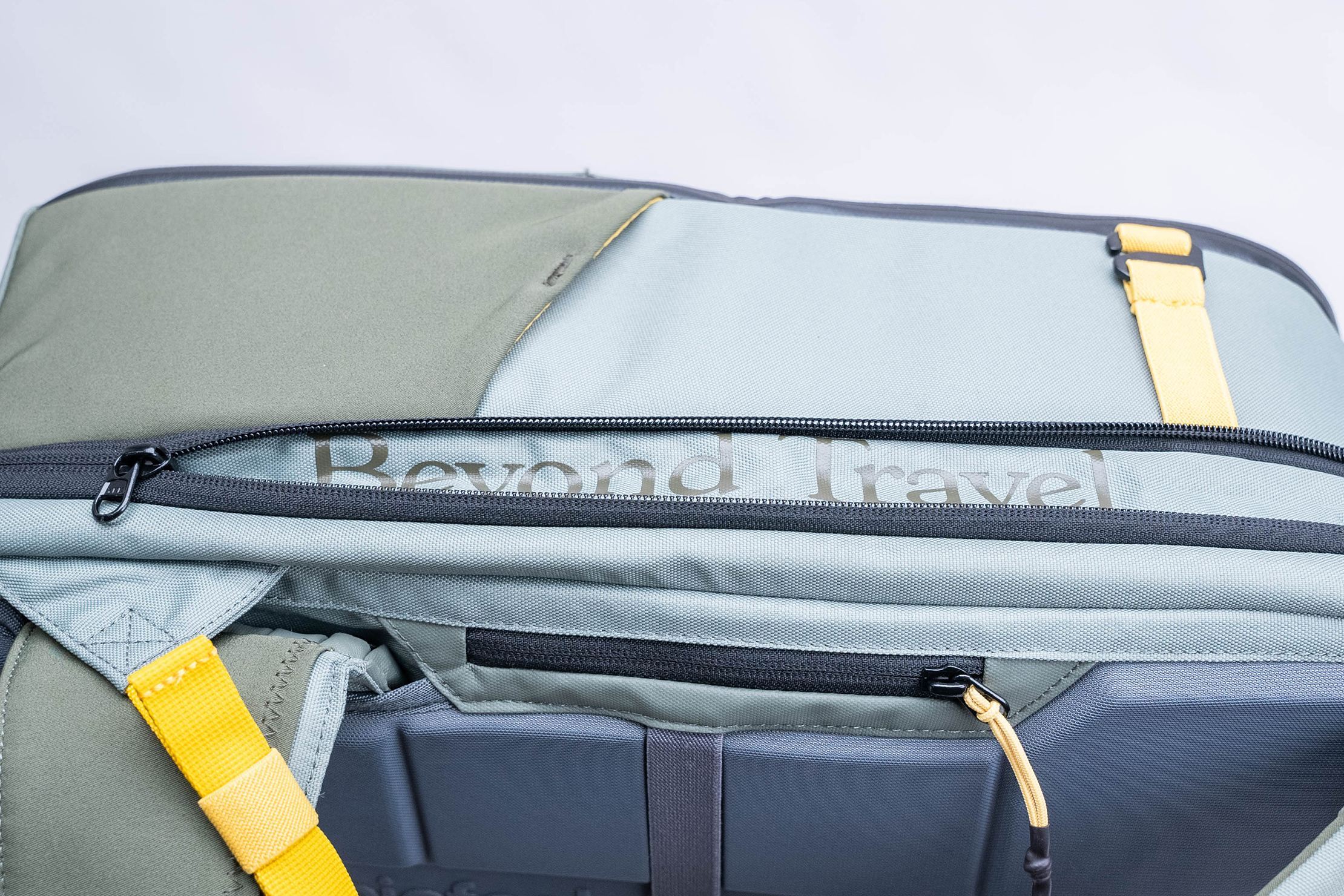
Oops, we forgot to mention an important feature! You can’t use the Wardrobe until you expand the pack. Remember that other zipper on the bottom we glazed over when chatting about the Kangaroo pocket? That’s the expansion. It runs around the bag, giving you a few extra centimeters of space so that you can fit more in the pack (or can fit the Wardrobe inside).
If an entire wardrobe isn’t your thing (or you’re using the 12-liter Smart Packing Cube externally), you can use the Camera Cube XXL inside the main compartment. It fits nicely in the bottom of the pocket and has a few inches of extra space on the top for goodies. The cube itself is fine—it isn’t anything revolutionary. It has lots of dividers, is sturdy, and will transport your gear as expected. When you open the lid of the camera cube, you can attach it to the hook-and-loop fastener on the laptop compartment closure so that you can quickly access your camera gear when you open the Hive, turning it into a makeshift camera bag, which is unique.
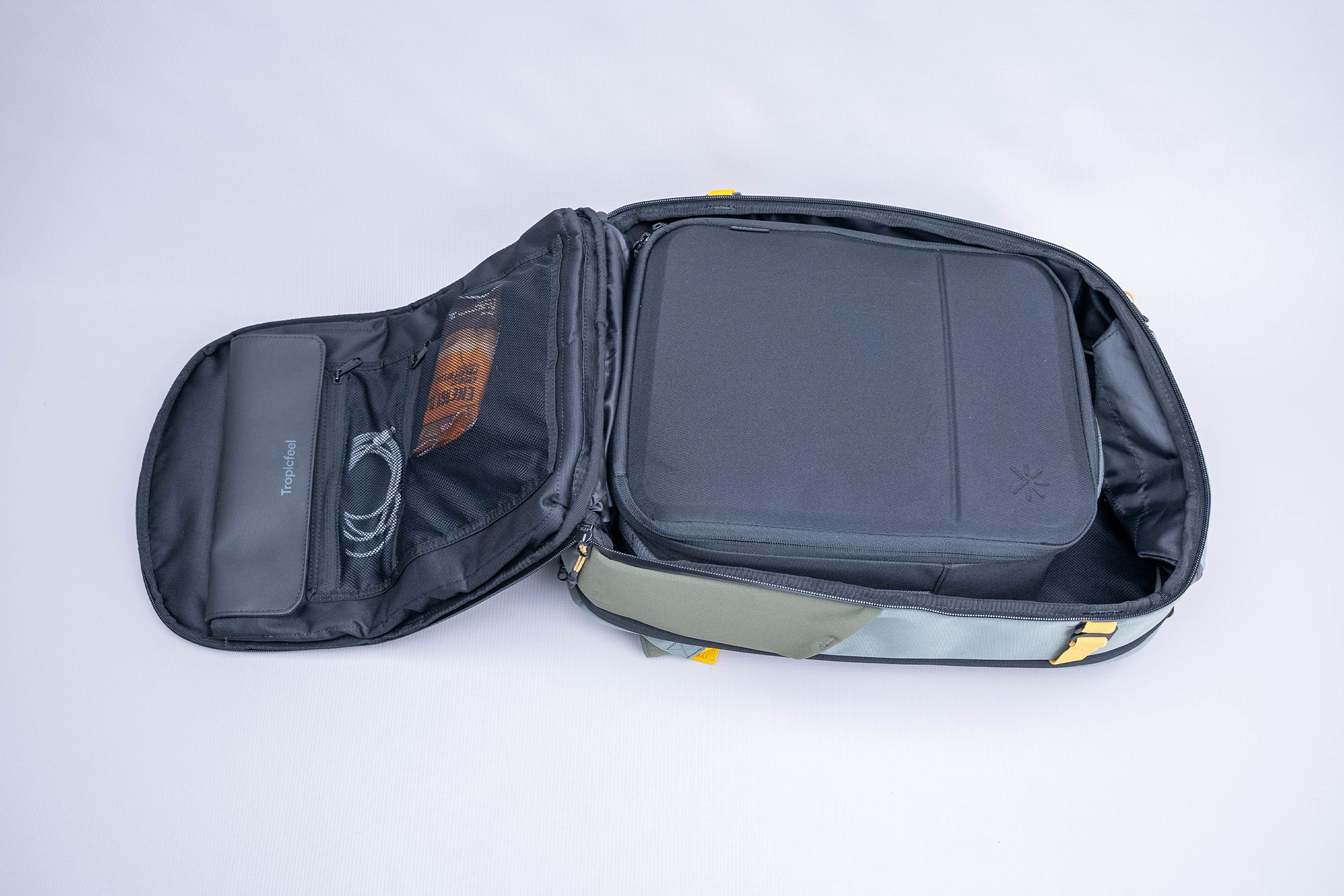
We’re not sure we like the idea of compromising the lid of our laptop compartment to do this, though, so you might want to leave that at home while shooting. However, we’ve had no issues with the laptop falling out. It’s just one of those things that might give anyone with a shred of anxiety the heebie-jeebies.
If you’re going on a road trip or flying with a carry on, you can get crafty with how you use the Hive (depending on your airline). On a road trip, you can load your camera cube up and leave that in your trunk or passenger seat for quick access while your clothing is hidden away in the Tropicfeel Wardrobe inside the Hive Backpack. Or, if you’re flying, use the clothing-stuffed Hive (and Wardrobe) as your carry on and the Camera Cube as your personal item (that’s the airline-dependent bit). The world is your oyster!

Overall, the Hive is more of a system than a backpack, which is only effective if it works for you and is used properly. However, when running smoothly, it’s incredibly efficient and fun to use. This isn’t a backpack to buy willy-nilly because you’ll spend a ton of money to get all the components. If you’re starting and want to go all in on one system and like the sound of the products mentioned here, this might be the pack for you.
Usage Timeline
Condition: Excellent
- Recycled materials feel durable and lightweight
- Much of the hardware is metal—which feels premium
- Modularity is top dog—we’re excited to test it
Condition: Excellent
- Materials and hardware have held up well
- No issues using any of the modular and expandable features
- Can feel tight on those with larger frames

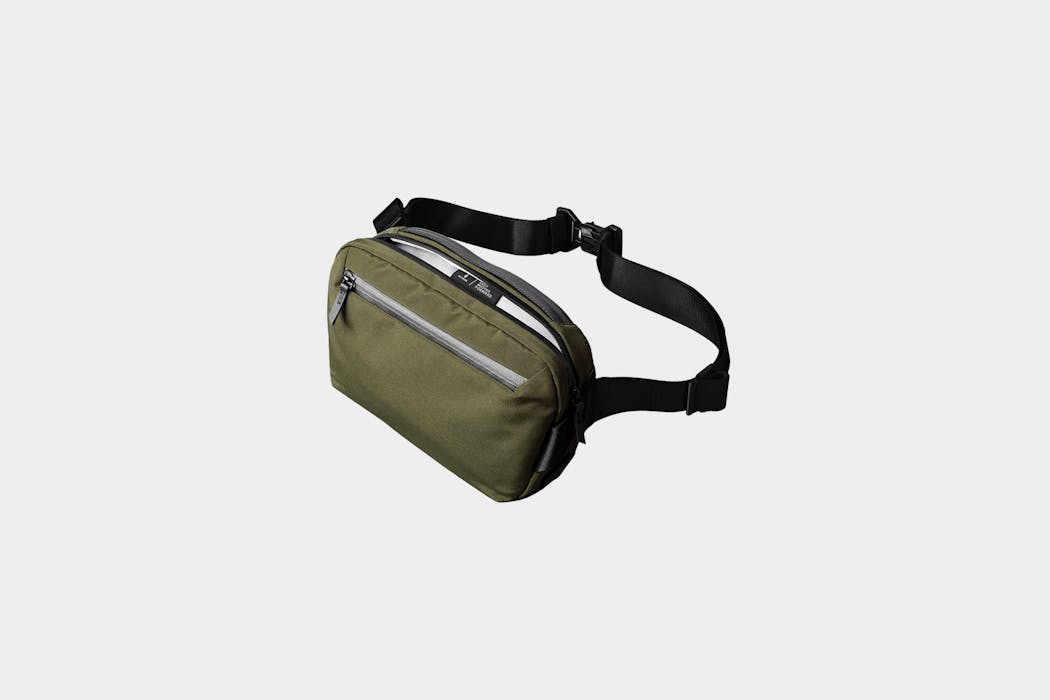

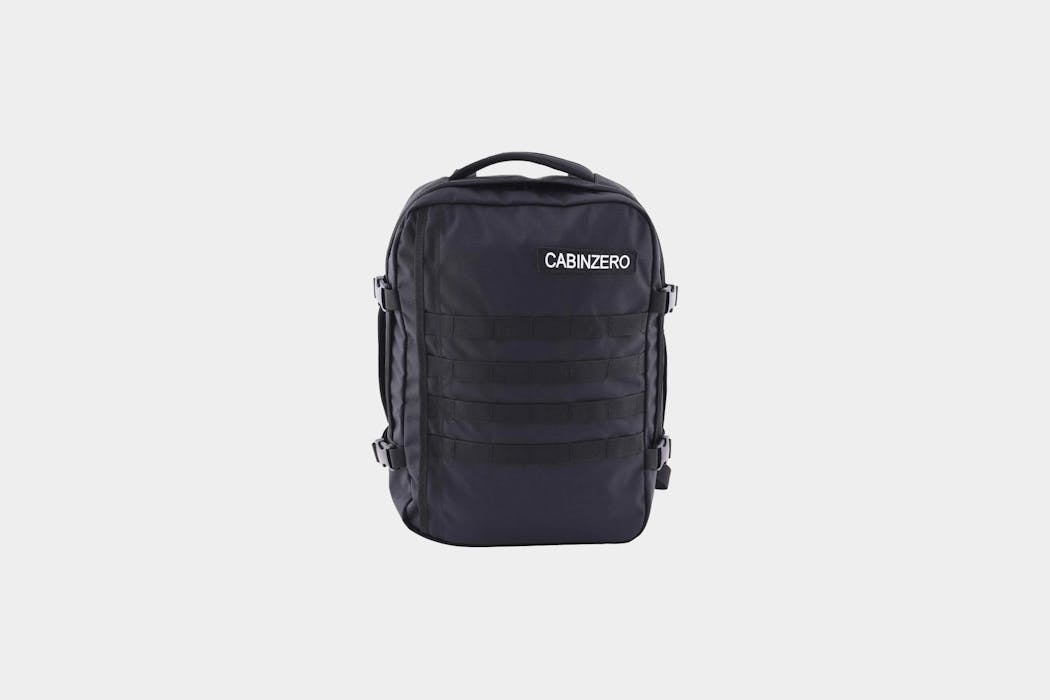

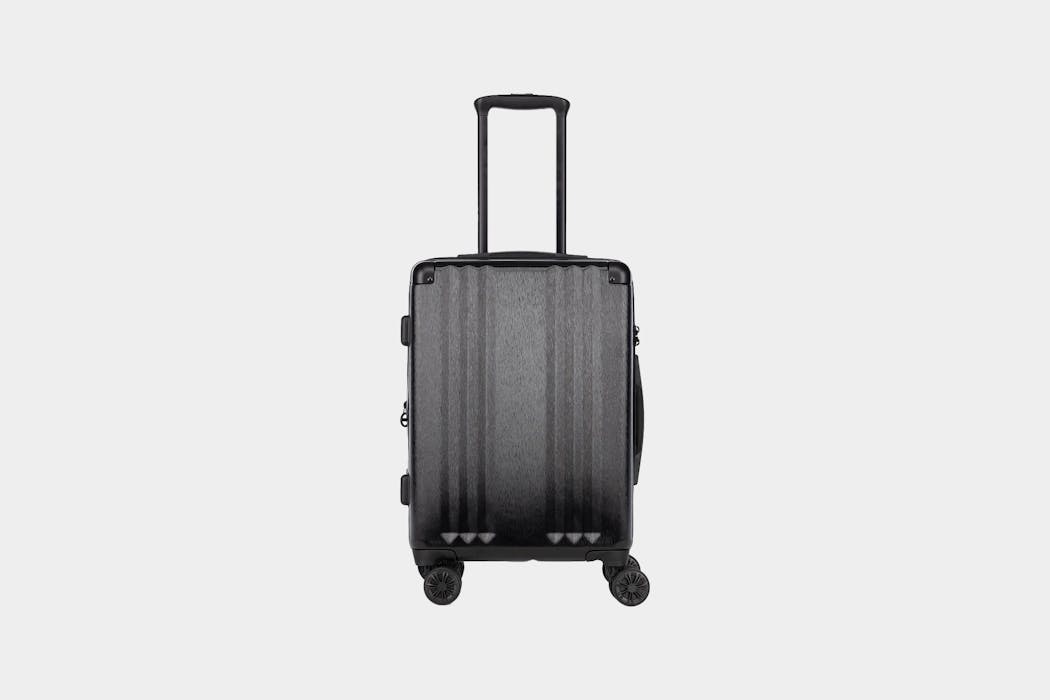

Get your questions about the Tropicfeel Hive Backpack answered from our team and the Pro Community right here on the page. Plus, join discussions with other members about gear, guides, and more.
Join Pack Hacker Pro or, Sign In